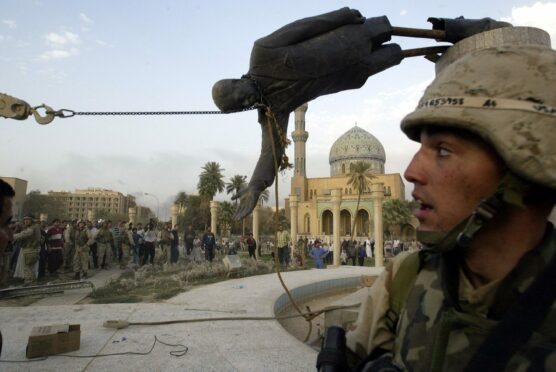
Revered or reviled, their place in society has been vigorously debated since anti-racism protesters threw the likeness of slave trader Edward Colston into Bristol harbour last summer.
Author Peter Hughes tells Patricia-Ann Young the Honest Truth about statues.
Why do statues hold so much symbolic power?
Statues are the stone, marble and steel on to which we carve our identities. They stand for the beliefs and values that bind us as a society.
When societies fracture, statues we barely noticed become lightning rods for love and hate: we protect the statues we love and destroy the statues we hate.
Statues act as expressions of who we are and what we stand for, so we see an attack on them as an attack on us.
It’s this symbolic power that explains why the destruction of statues is a marker on the road to the killing of people.
How have leaders used statues to solidify their power?
When power is tyrannical, the primary function of statues is to intimidate. An example of this was the statue of Stalin in Budapest, Hungary. Erected in December 1951, it reached a height of 25 metres and dominated the landscape.
The statue of Saddam Hussein in Firdos Square, Baghdad, built to celebrate his 65th birthday in 2002, served the same purpose. It was destroyed after the American invasion in 2003.
The statue of Stalin lasted five years before it was destroyed by a crowd.
What do statues tell us about a society’s history and values?
When statues are destroyed, it marks a shift in the beliefs and values of a society. For example, in 1996 in Qufu, China, Red Guards marked the beginning of the Cultural Revolution by breaking into Confucius’ ancestral home and desecrating the graves of his family before throwing a statue of Confucius on to a fire.
This was an attack on what revolutionaries called the Four Olds: Old Habits, Old Culture, Old Customs and Old Ideas.
At the time Red Guards destroyed the statue of Confucius, students began humiliating, beating and eventually killing their teachers.
What, in your opinion, has been the most impactful destruction of a statue?
In 2001 the Taliban, urged on by Osama bin Laden, blew up the Buddhas of Bamiyan six months before the attack on the Twin Towers.
After the Towers fell, Bin Laden said: “The pieces of the bodies of infidels were flying like dust particles.”
The same was true of the bodies of the Buddhas.
When the Taliban regained control of the country this summer, they destroyed the statue of a militia leader they tortured and executed in 1995.
What is it about statues that have made people believe they are literally supernatural?
Many civilisations have believed that statues contained the spirit of the person they represented. A statue of the Egyptian pharaoh Hatshepsut had its nose cut off to stop her spirit from entering the afterlife and in the 9th Century, John the Grammarian ordered his men to decapitate a statue of Hecate, the goddess of magic and witchcraft, in order to free her spirit to attack invading armies.
The violence with which statues, such as that of the slave trader Edward Colston are attacked, suggests we still believe, at least unconsciously, that statues contain spirits.
What statue do you think best represents hope and love?
In 2020 in New York, a statue of Frederick Douglass was torn off its plinth. Douglass was born a slave in 1818, escaped in 1838 and became the first African American to be appointed a US Marshall. His universalism and belief in the potential of the US Constitution were foundational to the Civil Rights movement.
His statue stood as a testament to his belief in the primacy of our shared humanity and his spirit of forgiveness. “I have no heart,” he wrote, “to visit upon children the sins of their fathers.”
What is your favourite statue?
Käthe Kollwitz’s The Grieving Parents. Kollwitz lost her son in the First World War and The Grieving Parents are statues of her and her husband, kneeling, overwhelmed with grief as they look at the graves of 25,000 dead soldiers, one of whom is their son.
The Grieving Parents bear witness to the grief of all parents who lose children and they stand as a refusal to let the past die without a witness.
A History Of Love & Hate In 21 Statues by Peter Hughes is published by Aurum, out now

Enjoy the convenience of having The Sunday Post delivered as a digital ePaper straight to your smartphone, tablet or computer.
Subscribe for only £5.49 a month and enjoy all the benefits of the printed paper as a digital replica.
Subscribe